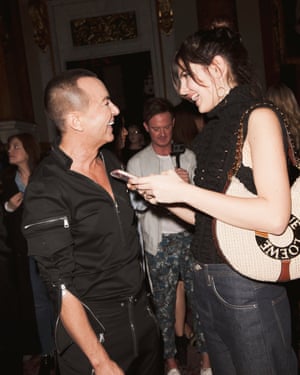he front row is a world divided. Montagues and Capulets, in bare legs rather than doublet and hose. Between the two blocs – editors on the one hand, “influencers” on the other – there is little love lost. Last autumn, American Vogue staffers branded the influencers “pathetic”, describing the job as “turning up, looking ridiculous, posing, twitching in your seat as you check your social media feeds”. The influencers hit back, branding their Vogue attackers as haughty and out of touch. (“Get back to your Werther’s Originals,” was a particularly choice comeback.) We think they are airheads; they think we are fogeys. So, to find out who’s right, I have arranged a job swap at London fashion week. Doina Ciobanu is 22, has 225,000 followers on Instagram (at time of writing), and attends shows as a model, VIP guest and brand ambassador. Ciobanu grew up in the former Soviet republic of Moldova, where she began blogging aged 16. She moved to Bucharest at 19, and now lives in London. For Saturday at London Fashion Week, I will do her job and she will do mine.
My job is to write about the shows. Writing to deadline frames my days and everything else – designer interviews, checking out up-and-comers, analysing emerging trends – has to fit around that. Doina’s job is to provide online content, mostly self-portraits with fairly brief captions, some of which are arranged in collaboration with labels whose clothes or beauty products she wears in the photos. I am an expert; Doina is an avatar.
The unspoken fashion editor dress code is low-key. Black trousers and a navy jumper is fine. The goalposts have shifted over the past decade, as fashion week has become a more public event – but still. Today, however, I am an influencer. So my first outfit is a new-season Gucci logo T-shirt, Mih wide-legged, floor-sweeping jeans, a checkedSimone Rocha jacket with puffy sleeves, to which I have added my own black Nicholas Kirkwood shoes and a cherry-red Alexander McQueen bag that is many years old. The outfit feels cumbersome, both literally (I can’t get the belt to sit right, and I’m terrified of tripping over the hem of the jeans) and figuratively. It takes up a lot of mental space, being dressed like this.
I meet with Doina in a Pret near London Wall, around the corner from the Julien Macdonald show. She has come dressed as a journalist, in jeans and a black sweater, with her hair in a bun. But she doesn’t look like a journalist at all, not just because the sweater is a fancy one that Julien sent over this morning for her to wear to the show, but because she is 22 and, like most of the new wave of influencers, absurdly beautiful. Imagine Kendall Jenner crossed with Emily Ratajkowski, and you get the idea: not just gorgeous, but with a specific aesthetic that is millennial catnip. Eyes disproportionately large, cheekbones defined even in repose, she looks like an animated Snapchat filter.
Doina’s favourite book, she tells me, is Plato’s Republic. She reads newspapers in English – the Wall Street Journal and the Financial Times – but fiction in Russian. (“A lot of things in life, you can express them better in Russian.”) Her life plan is first to build a brand along the lines of Chiara Ferragni, aka The Blonde Salad, the 29-year-old Italian influencer who has built a personal brand worth an estimated £10m, and then to become the first female president of Moldova. “I have plenty of time,” she says. “I will do this first, and then, when I am 40, perhaps I will go into politics.” I am 43. What have I been doing with all my time?
Outside the show, Doina greets the streetstyle photographers with kisses before obligingly recrossing the road so they can get a better shot of her arriving. And then crossing the road again, so they can get the shot again. And again, and again. She does this eight or nine times, allowing each photographer to capture the same reportage-style shot of her, apparently serenely indifferent to the lens. These images will appear on streetstyle blogs; the photographers will tag her, so she can find and regram the images.
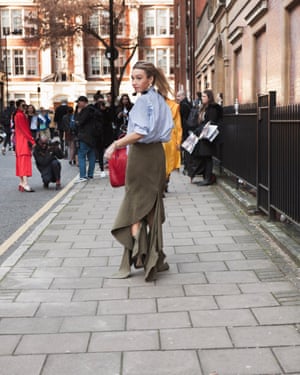
Being Doina is a complex business. Some brands pay her to model in their social media marketing, others pay her to endorse their products. An agent negotiates fees. “He looks at what a regular model would get paid, and at what a top celebrity would get paid, and pitches me somewhere in the middle,” she explains. A brand will send Doina images or samples of a new season’s products – it could be a mascara or a piece of jewellery – and “if I like the brand and it fits my aesthetic”, she will select pieces she is happy to endorse. But many posts are unsponsored, starring Doina in clothes she has bought or borrowed. These reinforce her aesthetic and voice, and build following.
The resistance of the fashion establishment to the likes of Doina is one part anxiety (the elite always fear becoming obsolete), one part snobbery (there have always been It girls who got photographed outside shows, but they used to be debutantes, the goddaughters of the elite, not young women from Moldova), and one part ethical suspicion that there is something compromised or false about the influencer role. This last part is tricky to unpick. Authenticity means something different for Doina’s generation than for mine. A tiny example: halfway through our day, a shot appears on Doina’s Instagram account of her in a cafe, captioned “much-needed coffee between shows”; we haven’t stopped for coffee. But when I bring it up, she is politely nonplussed by how baffled I am. In the run-up to busy periods, she explains, she will often prepare posts so as to have appropriate content ready to go. That the photo wasn’t taken on the day doesn’t strike her as in any way fake. Her social media isn’t a logbook of her life, it’s a contemporaneous brand-strategy document. So long as she’s the one calling the shots, then it is true to herself, because it is true to her vision of herself.
To Doina, being independent of commercial alliance is not aspirational. A generation who have grown up dreaming of becoming personal brands do not treat brands with suspicion. Now that every man and woman is her own brand, The Man is the bogeyman no more. If the designer of a dress she likes will pay Doina to wear that dress, that’s not a compromise, it’s win-win. Indeed, she sees herself as a force for good. “I want to get involved in female rights in eastern Europe, because no one is fighting for this,” she says. Moldova is one of the poorest countries in Europe, and its female population face significant discrimination. A 2010 study by the National Bureau of Statistics found that 63% of women had experienced psychological, physical or sexual violence from their husband or partner. In her efforts to use her profile to help the cause, Doina has been in touch with UN Women in Moldova, “and with Versace, who are very interested in talking about female empowerment”, she adds, as if the UN and Versace were two comparable platforms.
Doina’s business model is resolutely digital, but her aesthetic is absolutely within the glossy magazine tradition. Her Instagram is all bubble baths in chic hotel rooms, soulful evening strolls along the Seine. “My content is always aspirational,” she says, “and that takes time. I can’t take a photo if there’s litter on the pavement.” So there is, inevitably, a disconnect between the carefree tone of her content and the effort required. The Julien Macdonald show runs half an hour late, so it’s a race against the clock across to London to a meet-and-greet for influencers with Gigi Hadid at the Tommy Hilfiger store, an appointment that is as significant in Doina’s diary as any fashion show. Hadid, with nearly 32m followers on Instagram, is digital fashion royalty.
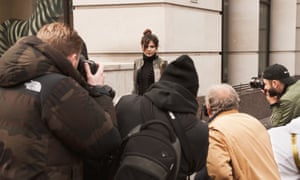
During fashion week, my life involves a lot of small talk with whoever I happen to be seated next to. But in Doina’s world, communication through a screen trumps talking to the people who are around you every time. It’s a numbers game: if an influencer has to choose between talking to the thousands of people who are with her on social media or the three people in her taxi, she will naturally prioritise the thousands. In the cab on the way to Knightsbridge, she breaks off our conversation to post a video on her Instagram story telling her followers that she is in a cab on the way to Knightsbridge. At the Tommy Hilfiger shop, influencers nod greetings to each other and get on with the business of posting photos to their followers. After the rush to get here, Hadid is running late and I am now regretting having passed up the opportunity to eat at Pret. The room is lavishly catered with beautiful food that does not seem intended for actual consumption. There are miniature burgers, but the beef patties are sandwiched between macaroons rather than bread buns. It looks shareable, but only in the digital sense. When Hadid arrives, she and Doina say hello and then, even before Doina has lifted her phone aloft, they both automatically fluff their hair and position their faces next to each other for a selfie video, which Doina immediately posts on her Instagramwith the caption “keep running into this beauty”.
By now I am starving. But there’s no time to stop, because we are racing back along the river for a fly-by visit to the Astley Clarke presentation at the Institution of Engineering next to the Savoy hotel, before a two-mile dash north to Bloomsbury and the JW Anderson show. Doina’s sweet face clouds over when she realises she has been neglecting her Snapchat over the last couple of hours. “If I forget,” she says, “my mum or boyfriend will text to nag me about it.” She works “every day from morning until midnight or 2am”. At Christmas, she took three days off from social media. “Those were my only days off in the past three years,” she says. This is the only time I hear Doina being remotely negative about anything. Being an influencer might be hard work, but to make it lucrative it has to be aspirational, so you have to look like you are having fun at all times.
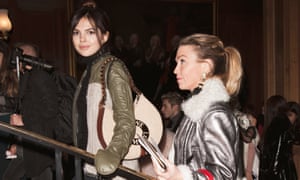
One of the key differentiators between editors and influencers is that while we wear the same clothes all day, give or take a 9pm black tie upgrade, influencers will often change into an outfit by the designer of each show they attend. So, on the way to JW Anderson, I commandeer the backseat of a British Fashion Councilcar to change into a skirt and shirt by the designer. The stress of being in my bra and knickers in broad daylight, fumbling to fasten shirt buttons in time to make the next show, rattles me more than any copy deadline does. I completely forget to put the coordinating earrings on, and give up on changing shoes, because the skirt is much too long and has a tentacle-shaped hemline that I swear is trying to kill me. But it turns out you do have to suffer for fashion. The killer skirt works. The photographers outside the show love it, and my picture ends up on American Vogue’s Best Street Style Pics from London’s Fall 2017 Shows. Still, you can tell I’m not meant to be there: everyone else in the gallery is studiously avoiding eye contact with the photographer for the preferred “candid” format. I am smiling at the camera. Total sophistication fail.
Doina is much better at my job than I am at hers. After the show, we head toEmilia Wickstead, and soon afterwards she files her reviews to me for feedback. They are excellent. From her Julien Macdonald review: “Female empowerment is a term du jour. But where New York’s designers offered up feminism in the guise of slogan tees, Macdonald interpreted it through his concept of a future where clothes are made on-demand, tailored to the shape of every woman.”
We go our separate ways for a short time, and when I see her again at the 9pmVersus show, I am reminded of the famous quote about Ginger Rogers and Fred Astaire: that she did everything he did, backwards and in high heels. Doina has used the hour to change out of her jeans and into a fuchsia tuxedo suit with a black lace camisole and spike-heeled sandals. And me? I ate a pizza.
Doina’s week as Jess: ‘I’m probably having more fun’
I work hard at the fashion shows, but I’m not going to pretend it’s not glamorous. You can see that on my Instagram feed, where I’m skipping down a crumbling staircase in Paris or posing in a Louis Vuitton minidress in Milan. What you don’t see is the behind-the-scenes effort: the months of meetings beforehand, the Google doc full of contact details for designers, so I don’t end up wearing the same Gucci loafers as everyone else. You don’t see the last-minute panics on show day: changing my outfit in the car while my driver tactfully waits on the pavement; shoving protein bars into my mouth between appointments.
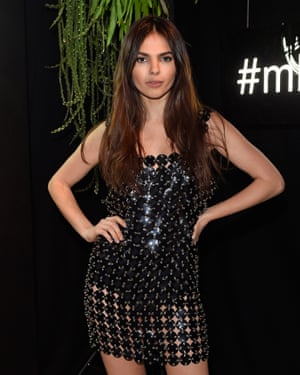
I’ve always been fascinated by the journalists I see at fashion week. I like how serious they look. They are in their own world, while I’m talking to my followers on my two phones. We’re both working, but I feel like I’m probably having more fun. I love print journalism; I love to feel a magazine in my hands; I know some people think it’s irrelevant these days, but I really hope that is not the case.
The Guardian’s fashion team asked me to make like a journalist and wear one simple outfit, rather than get changed between the shows. That was a liberation: no desperate rush to find somewhere to change. I even had time to buy a coffee.
At the Julien Macdonald show, it felt very strange to be taking notes, rather than pictures. It’s such a tight space on the front row that a notebook and pen were useless. As soon as the clapping had finished, I rushed backstage, as instructed, to grab a quote. Macdonald was friendly, but I was in a crush of other journalists, everyone is muscling in, trying to congratulate him or ask questions. I had to manage all that, and say something intelligent, and take notes, too. It’s very different from meeting a designer as an influencer, when I’ll kiss them on the cheek and say, “I love your clothes”, and they’ll say, “You look beautiful”, and that’s it.
I wrote the review on my phone, while walking down the street between shows. It was stressful. I’m used to writing one thing quickly on Instagram; I don’t need to give that a lot of thought. But a lot of people are going to read this, and there’s an additional layer of stress that comes from knowing that it’s the Guardian.
My next assignment, an Emilia Wickstead report, was harder. We were short of time, so I didn’t go backstage to speak to her and had to come up with an analysis on my own. It was the end of the day, I was hungry, I was tired, my brain wasn’t working. I started writing the piece on the way home; the deadline seemed impossibly soon and I was anxious to make it good.
I studied political science and history, so I love understanding the cause of events. Being a journalist for a day gave me a chance to flex those analytic muscles; as an influencer, you simply look at what looks good on people, what you think people would like. I’d love to use my brain more in that way in the future, by getting more involved in activism, using my following for good. But I wouldn’t be a journalist. I’m an independent soul. Usually, when I’m working, I’m the brand. As a journalist, it’s not about you.
Doina’s Julien Macdonald review
All hail female empowerment. Or so indicated designer Julien Macdonald backstage after successfully debuting his autumn/winter 2017 collection.
Female empowerment, feminism and their ilk are the terms du jour for the fashion set right now. New York fashion week gave collection after collection where women’s rights were the focus. But where New York’s designers offered up feminism in the guise of slogan tees and underwear surely destined for fame as a hashtag, Macdonald interpreted it through his concept of a future where technology has such an impact on fashion that clothes are made on demand, tailored to the shape of every individual woman.
For Macdonald that is, of course, a particular style of clothing and a particular type of woman. One empowered, one confident. If feminism is a thread that runs through Macdonald’s winter 2017 collection, it’s the same feminism that the likes of Emily Ratajkowski can be found celebrating: that a woman can express herself and her person at a time of her choosing, Laura Mulvey’s “male gaze” be damned. Appropriate, then, that Ratajkowski has done much justice to Macdonald’s designs before now.
Macdonald does a style and he does it well. His hallmark spiderweb dresses are still to be found, but increasingly with straighter lines and alongside dresses offering a sleeker and more futuristic vision. Macdonald told me that his inspiration was “modern architecture, big cities [and] the metropolis”. His autumn/winter 2017 may be inspired by a future landscape, but there’s also an air of the imagined future that the likes of Fritz Lang once saw for us. Nostalgia, the present, and the future always go hand in hand.


